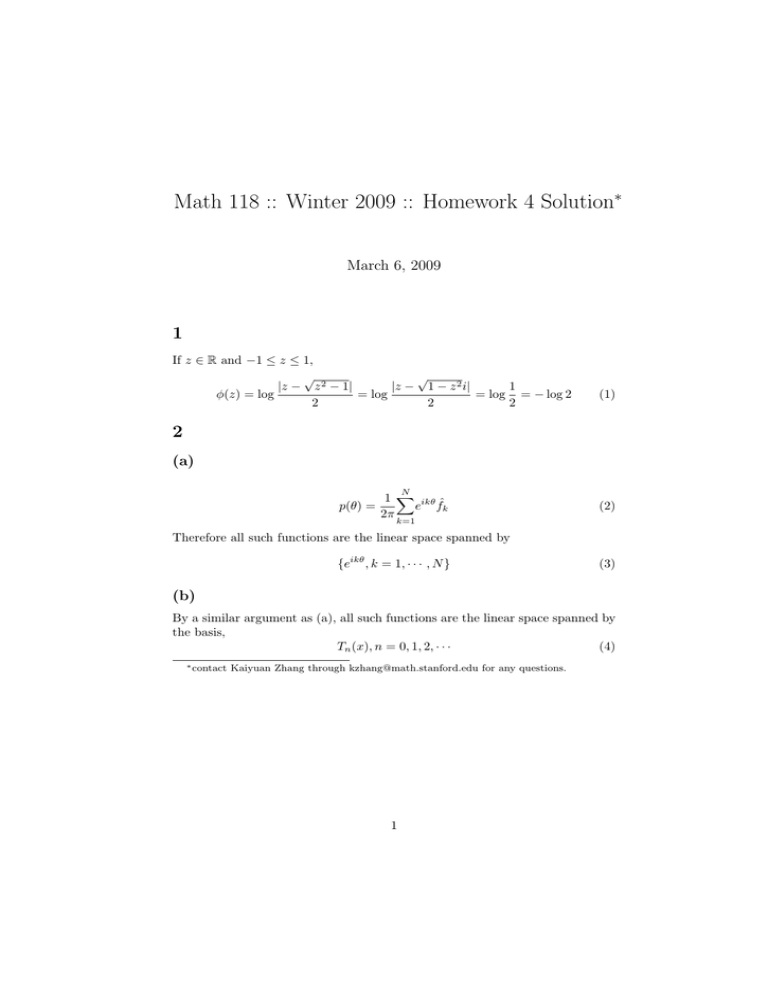Math 118 :: Winter 2009 :: Homework 4 Solution 1 2 ∗
advertisement

Math 118 :: Winter 2009 :: Homework 4 Solution∗
March 6, 2009
1
If z ∈ R and −1 ≤ z ≤ 1,
√
√
|z − z 2 − 1|
|z − 1 − z 2 i|
1
φ(z) = log
= log
= log = − log 2
2
2
2
(1)
2
(a)
N
p(θ) =
1 X ikθ ˆ
e fk
2π
(2)
k=1
Therefore all such functions are the linear space spanned by
{eikθ , k = 1, · · · , N }
(3)
(b)
By a similar argument as (a), all such functions are the linear space spanned by
the basis,
Tn (x), n = 0, 1, 2, · · ·
(4)
∗ contact
Kaiyuan Zhang through kzhang@math.stanford.edu for any questions.
1
3
(a)
¯Z
¯
¯ π/h
¯
¯
¯
eikxj (û(k) − v̂(k))dk ¯
¯
¯ −π/h
¯
Z π/h
1
≤
|û(k) − v̂(k)|dk
2π −π/h
Z π/h
1
²
1dk
≤
2π −π/h
²
=
h
1
|uj − vj | =
2π
(5)
(6)
(7)
(8)
(b)
By Theorem 3 on p.33, we have
|û(k) − v̂(k)| ≤ M hp+1
(9)
\
|(u(ν)
− v (ν) )(k)|
=|(ik)ν û(k) − (ik)ν v̂(k)|
=|k|ν |û(k) − v̂(k)|
π
≤( )ν M hp+1
h
=M π ν hp−ν+1
(10)
(11)
(12)
for some constant M . Then
(13)
(14)
Let ² = M π ν hp−ν+1 , by part (a),
|u(ν) (xj ) − wj | = |u(ν) (xj ) − v (ν) (xj )| ≤ ²/h ≤ M π ν hp−ν
2
(15)
4
Z
1
f (x)dx − h
0
=
N
−1
X
ÃZ
=
!
f (x)dx − hf ((j + 1/2)h)
(17)
(f (x) − f (xj )) dx
(18)
jh
N
−1 Z (j+1)h
X
j=0
(16)
(j+1)h
N
−1 Z (j+1)h
X
j=0
f ((j + 1/2)h)
j=0
jh
j=0
=
N
−1
X
µ
¶
1
1
f 0 (xj )(x − xj ) + f 00 (xj )(x − xj )2 + f (3) (xj )(x − xj )3 + o(h3 ) dx
2
6
µ
¶
1 00
f (xj )(x − xj )2 + o(h3 ) dx
2
(20)
¶
1 00
h2
3
f (xj ) + o(h ) dx
2
12
(21)
jh
(19)
=
N
−1 Z (j+1)h
X
j=0
=
N
−1 Z (j+1)h
X
j=0
=
jh
N
−1 µ
X
j=0
=
jh
µ
¶
1 00
h3
4
f (xj ) + o(h ) dx
2
12
(22)
N −1
h3 X 00
f (xj ) + o(h3 )
24 j=0
Thus
(23)
¯
¯
¯Z 1
¯
N
−1
X
¯
¯ kf 00 k∞ 2
¯
¯≤
h + o(h3 )
f
(x)dx
−
h
f
((j
+
1/2)h)
¯
¯
24
¯ 0
¯
j=0
5
(a)
Since f ∈ L2 , let p = 0, then we know that the error is O(h).
3
(24)
(b)
The error equals the difference between red shadow part and the green shadow
part, which does not exceed h = 2π/N .
(c)
We claim that the error is π/N now. If N is even,
µ
¶
N/2−2
N
−1
X
X
1+
1
2πj
2π(j + 1)
h
f(
) + f(
) =h
1+
2
N
N
2
j=0
j=0
1
2
+
1
2
+0
= hN = π
2
2
(25)
If N is odd,
h
N
−1
X
j=0
1
2
µ
¶
(N −3)/2
X
2πj
2π(j + 1)
1
+
0
= h N = π (26)
f(
) + f(
) = h
1+
N
N
2
2
j=0
Therefore the error is π − π = 0.
6
f ∗ g = f tells fˆ(k)ĝ(k) = fˆ(k). Therefore
ĝ(k) = 1, −B ≤ k ≤ B
(27)
We need to extend ĝ to the entire real axis with sufficient smoothness.
ĝ(k) = exp(−(|k| − 1)4 )
4
(28)
for |k| > 1. We claim that ĝ ∈ C 2 and ĝ 00 ∈ L1 (R). In fact, at k = 1,
exp(−(|k| − 1)4 ) = 1 − (k − 1)4 + o((k − 1)4 )
(29)
is C 2 connected with ĝ|−1≤k≤1 = 1. Similarly, the connection at k = −1 is also
C 2 , therefore ĝ ∈ C 2 .
kĝ 00 kL1 (R)
¯
Z ∞¯ 2
¯d
¯
4 ¯
¯
=2
exp(−(k
−
1)
)
¯ dk 2
¯ dk
1
¯
Z ∞¯ 2
¯
¯d
4 ¯
¯
exp(−k
)
=2
¯ dk 2
¯ dk
0
Z ∞
=2
exp(−k 4 )|16k 6 − 12k 2 |dk
(30)
(31)
(32)
(33)
0
<∞
(34)
We know that −x2 g(x) is the Fourier inverse transform of ĝ 00 , hence
|x2 g(x)| ≤ kĝ 00 kL1 (R) ≤ M ⇒ |g(x)| ≤ M/|x|2
(35)
Let C = 2 max{M, sup|x|≤1 |g(x)|} < ∞, we have when |x| ≤ 1,
|g(x)| ≤
when |x| > 1,
|g(x)| ≤
C
1
≤C
2
1 + x2
(36)
C
1
≤C
2
2x
1 + x2
(37)
5











